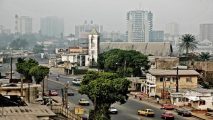Categories
Recent Posts
- CPDM Crime Syndicate repays CFA39.8bn debt with new borrowings
- Kenya: Helicopter crash kills defense chief and nine senior officers
- 4th Cameroon Investment Forum opens in Douala
- Cameroon doctors flee to Europe, North America for lucrative jobs
- Dortmund sink Atletico to reach Champions League semi-finals
Archives
- April 2024
- March 2024
- February 2024
- January 2024
- December 2023
- November 2023
- October 2023
- September 2023
- August 2023
- July 2023
- June 2023
- May 2023
- April 2023
- March 2023
- February 2023
- January 2023
- December 2022
- November 2022
- October 2022
- September 2022
- August 2022
- July 2022
- June 2022
- May 2022
- April 2022
- March 2022
- February 2022
- January 2022
- December 2021
- November 2021
- October 2021
- September 2021
- August 2021
- July 2021
- June 2021
- May 2021
- April 2021
- March 2021
- February 2021
- January 2021
- December 2020
- November 2020
- October 2020
- September 2020
- August 2020
- July 2020
- June 2020
- May 2020
- April 2020
- March 2020
- February 2020
- January 2020
- December 2019
- November 2019
- October 2019
- September 2019
- August 2019
- July 2019
- June 2019
- May 2019
- April 2019
- March 2019
- February 2019
- January 2019
- December 2018
- November 2018
- October 2018
- September 2018
- August 2018
- July 2018
- June 2018
- May 2018
- April 2018
- March 2018
- February 2018
- January 2018
- December 2017
- November 2017
- October 2017
- September 2017
- August 2017
- July 2017
- June 2017
- May 2017
- April 2017
- March 2017
- February 2017
- January 2017
- December 2016
- November 2016
- October 2016
- September 2016
- August 2016
- July 2016
- June 2016
Featured
Most Commented Posts
 4 Anglophone detainees killed in Yaounde
4 Anglophone detainees killed in Yaounde
19 comments Chantal Biya says she will return to Cameroon if General Ivo Yenwo, Martin Belinga Eboutou and Ferdinand Ngoh Ngoh are sacked
Chantal Biya says she will return to Cameroon if General Ivo Yenwo, Martin Belinga Eboutou and Ferdinand Ngoh Ngoh are sacked
13 comments Anglophone Nationalism: Barrister Eyambe says “hidden plans are at work”
Anglophone Nationalism: Barrister Eyambe says “hidden plans are at work”
12 comments The Anglophone Problem – When Facts don’t Lie
The Anglophone Problem – When Facts don’t Lie
12 comments Largest wave of arrest by BIR in Bamenda
Largest wave of arrest by BIR in Bamenda
10 comments
Latest Tweets
Featured
-

CPDM Crime Syndicate repays CFA39.8bn debt with new borrowings
-

Kenya: Helicopter crash kills defense chief and nine senior officers
-

4th Cameroon Investment Forum opens in Douala
-

Cameroon doctors flee to Europe, North America for lucrative jobs
-

Dortmund sink Atletico to reach Champions League semi-finals
-

US: Trump media group plans TV streaming platform
-

Cameroon is broken: Who can fix it?
© Cameroon Concord News 2024





26, January 2022
Cameroonians express shock and anger after AFCON stampede 0
As football fans reel over the deaths of at least eight people outside Olembe Stadium, questions have been raised as to how the tragedy unfolded. There had been concerns about poor preparation ahead of the tournament.
Confederation of African Football (CAF) President Patrice Motsepe said a probe into the crush will begin immediately
Investigations are underway after at least eight people were killed and dozens more injured in a stampede outside a match at the Africa Cup of Nations (AFCON) football tournament in Cameroon’s capital, Yaounde.
The crush took place as large crowds tried to enter Olembe Stadium, where the host country was playing Comoros in a highly anticipated final-16 knockout game.
“Eight deaths were recorded, two women in their 30s, four men in their 30s, one child, one body taken away by the family,” said a preliminary report from the Public Health Ministry.
The tragedy has realized ongoing fears over the capacity of Cameroon to stage the continent’s largest sporting event.
“The local population is angry because information isn’t coming in on exactly what happened,” correspondent Blaise Eong told DW. “People are also angry that security forces outside the stadium could not contain the fans that were rushing into the stadium.”
CAF officials hold a moment of silence following the deadly stampede in Yaounde
‘No excuse’
Cameroonian President Paul Biya has ordered an investigation “so that all light is shed on this tragic incident,” Communications Minister Rene Emmanuel Sadi said.
Confederation of African Football (CAF) president Patrice Motsepe on Tuesday called for an immediate probe into the crush, with the first report to be submitted on Friday.
“There is no excuse for what has happened. We must show responsibility when people lose their lives and are injured,” he said.
“We will have very tough and very hard discussions behind closed doors,” he added.
‘Complete chaos’
“According to police sources on the ground, people tried to force their way into the stadium, and that’s when the stampede happened,” Eong said.
Witnesses on the ground at the time of the stampede said the crowd was surging towards an open entrance gate after a long wait outside the stadium. When stewards closed the gate, people continued trying to push forward.
“When the security guys finally began opening the gates, with all the anxiety and having been locked out, people pushed the security guys away and forced themselves inside,” witness Marie Asongafack said.
Witnesses say they tried to revive victims before emergency services arrived
“That’s where it all began,” she added. “By the time I found myself in front, there were people on the ground being trampled on.”
Another man told AFP that the entrance to the stadium was “complete chaos” as fans without tickets tried to find a way inside.
“I arrived a quarter of an hour before kickoff,” he said. “I had my ticket, but, all of a sudden, a group of people without tickets arrived and tried to force their way through and we found ourselves pushed up against the fences.”
In the aftermath of the crush, people were seen lying motionless on the ground as bystanders tried to resuscitate victims before medical help arrived.
The Public Health Ministry said victims were “immediately transported” away from the scene, but “heavy road traffic slowed down the transport.”
Witnesses also said children were among those caught up in the crush.
“I saw a child less than 10 years old, lifeless,” Asongafack said. “Guys were just trying to revive him.”
Stadiums in Cameroon are supposed to operate at reduced capacity according to pandemic measures
Families still searching for loved ones
There were scenes of chaos and confusion outside Messassi hospital after the incident, with at least 38 people hurt in the stampede in addition to those who were killed.
Public Health Minister Manaouda Malachie said 31 of the 38 injured people were responding well. Speaking to reporters, nurse Olinga Prudence said some of the injured “are in a desperate condition.”
People were still gathering outside hospitals in Yaounde on Tuesday morning, searching for missing family members.
“I am helpless: The police have not been of any help and I have not been able to trace my two brothers,” 24-year-old student Festus Ndi said.
Planning issues come to light
The tragedy in Yaounde has shone a spotlight on the preparation issues that plagued Cameroon in the lead-up to the football tournament.
Cameroon is hosting AFCON for the first time in 50 years. It was initially supposed to host the competition in 2019. At the time, it was stripped of its duties owing to serious issues with planning — especially when it came to infrastructure — as well as the ongoing Anglophone Crisis and Boko Haram insurgency.
Organizers were particularly concerned about Olembe Stadium, where the tragedy took place. The country’s largest stadium has a capacity of 60,000, but the crowd is supposed to be limited to 80% capacity in line with coronavirus measures.
In order to gain entry to AFCON matches, fans must show proof of a negative COVID-19 test and be vaccinated, alongside normal security checks at stadiums.
As news of the crush spread on social media, TV stations broadcast footage of people jumping over security fences amid reports that police were quickly overwhelmed.
“Clearly there were deficiencies, failures and weaknesses,” CAF president Motsepe said on Tuesday. “There were problems that should have been foreseen.”
Though no decisions on future measures at AFCON matches have yet been made, Eong said it was possible that stadium capacities would be reduced even further in light of the disaster.
“With this incident, we may find ourselves in a situation where the matches may go ahead without fans, or [organizers] may bring down the number of fans that can go to stadiums,” he said.
The quarterfinal match scheduled to be played at the stadium on Sunday will now be switched to the Ahmadou Ahidjo stadium in Yaounde.
Culled from DW